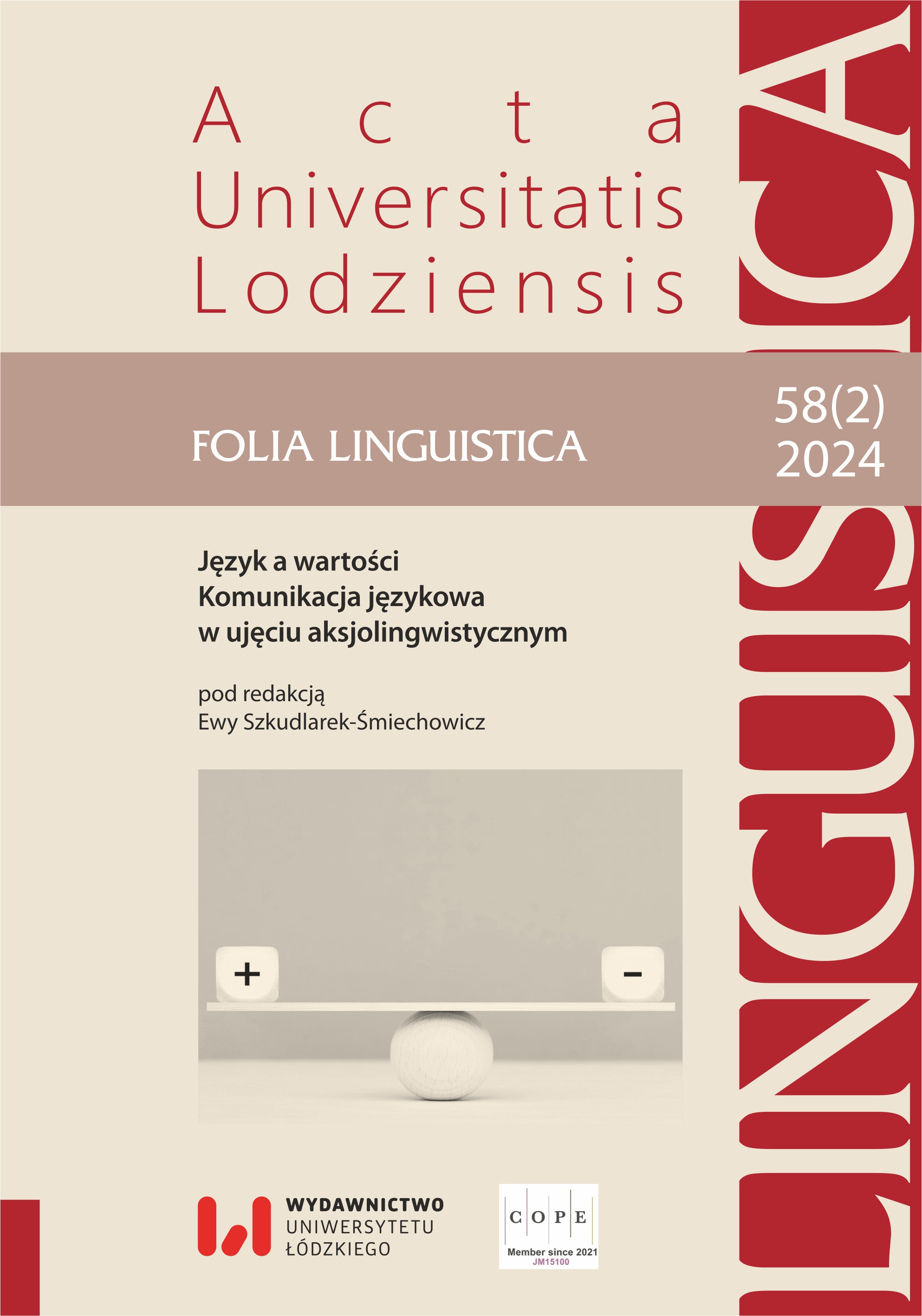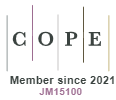Charakterystyka wartościowań wokół języka esperanto — perspektywa emiczna
DOI:
https://doi.org/10.18778/0208-6077.58.2.34Słowa kluczowe:
esperanto, ideologia, język mniejszości, lingua franca, tożsamość, wartościAbstrakt
W niniejszym artykule przedstawiony został przegląd badań socjolingwistycznych wraz z analizą etnolingwistyczną trzech typów danych: korpusów, dyskursu prasowego oraz wywiadów biograficznych w celu ukazania wartości, jakie przypisywane są językowi esperanto przez jego użytkowników. Międzynarodowy język planowy esperanto zgromadził wokół siebie prężną wspólnotę, w której — oprócz swojej pierwotnej funkcji języka pomocniczego — pełni także funkcje integracyjną i tożsamościową. Przeprowadzone analizy potwierdzają, że osoby zaangażowane w ruch esperancki i używające tego języka na co dzień powiązują z nim skomplikowany system wartościowań, którego centrum stanowi esperanto samo w sobie, zarówno jako język stworzony do komunikacji międzynarodowej, równościowy, jak i jako język mniejszości diasporycznej, którym jest w ocenie użytkowników.
Pobrania
Bibliografia
Alòs i Font H., 2012, Catalan Esperantists: Pacifists in a globalised world, „ICIP Working Papers”, nr 3, s. 1–64.
Google Scholar
Bartmiński J., Pazio-Wlazłowska D., Żywicka B., 2022, Leksykon aksjologiczny Słowian i ich sąsiadów — stan obecny i perspektywy kontynuacji, w: S. Niebrzegowska-Bartmińska, J. Szadura, B. Żywicka (red.), Nazwy wartości i koncepty kulturowe. Hierarchie i rekonstrukcje, Lublin: Wydawnictwo Uniwersytetu Marii Curie-Skłodowskiej, s. 9–17.
Google Scholar
Blanke D., 2001, Vom Entwurf zur Sprache, w: K. Schubert (red.), Planned languages: from concept to reality, Brussel: Hogeschool voor Wetenschap en Kunst, s. 37–89.
Google Scholar
Bourdieu P., 1991, Language and symbolic power, Cambridge: Polity Press.
Google Scholar
Caligaris I., 2016, Una lingua per tutti, una lingua di nessun paese: una ricerca sul campo sulle identità esperantiste, Ariccia: Aracne Editrice.
Google Scholar
Cramer M., 2021, Empirical study on the use of gender-neutral pronouns in Esperanto, w: I. Koutny, I. Stria, M. Farris (red.), Interkultura rolo de Esperanto / Intercultural role of Esperanto / Międzykulturowa rola esperanta, Poznań: Rys, s. 201–218. https://doi.org/10.48226/978-83-66666-31-3
Google Scholar
Farris M., 2017, Esperanto and the Market State, „Język. Komunikacja. Informacja”, t. 12, s. 113–120. https://doi.org/10.14746/jki.2017.12.8
Google Scholar
DOI: https://doi.org/10.14746/jki.2017.12.8
Fians G., 2021, Lingvo kiel ĉies propraĵo, ŝanĝo kiel ĉies rajto: Vortelekto, lingva aŭtoritato kaj normigado en Esperanto, w: I. Koutny, I. Stria, M. Farris (red.), Interkultura rolo de Esperanto / Intercultural role of Esperanto / Międzykulturowa rola esperanta, Poznań: Rys, s. 175–188. https://doi.org/10.48226/978-83-66666-31-3
Google Scholar
Fiedler S., 2002, On the main characteristics of Esperanto communication, w: K. Knapp, C. Meierkord (red.), Lingua Franca Communication, Frankfurt am Main: Peter Lang, s. 53–86.
Google Scholar
Fiedler S., 2012, The Esperanto denaskulo: The status of the native speaker of Esperanto within and beyond the planned language community, „Language Problems & Language Planning”, t. 36, nr 1, s. 69–84. https://doi.org/10.1075/lplp.36.1.04fie
Google Scholar
DOI: https://doi.org/10.1075/lplp.36.1.04fie
Fiedler S., Brosch C.R., 2022, Esperanto — Lingua Franca and Language Community, Amsterdam: John Benjamins, http://www.jbe-platform.com/content/books/9789027257536 (dostęp: 15.03.2024). https://doi.org/10.1075/wlp.10
Google Scholar
DOI: https://doi.org/10.1075/wlp.10
Galor Z., Pietiläinen J., 2015, UEA en konscio de esperantistoj, Dobrichovice (Praha): Kava-Pech.
Google Scholar
Gobbo F., Miola E., 2016, Modificare l’immagine linguistica: Esperanto e Piemontese a confronto, w: G. Agresti, J.-G. Turi (red.), Représentations sociales des langues et politiques linguistiques, Roma: Aracne Editrice, s. 287–304.
Google Scholar
Kimura G.C., 2012, Esperanto and minority languages: A sociolinguistic comparison, „Language Problems & Language Planning”, t. 36, nr 2, s. 167–181. https://doi.org/10.1075/lplp.36.2.05kim
Google Scholar
DOI: https://doi.org/10.1075/lplp.36.2.05kim
Koutny I., 2015a, Can Complexity be Planned?, „Interdisciplinary Description of Complex Systems”, t. 13, nr 2, s. 236–249. https://doi.org/10.7906/indecs.13.2.4
Google Scholar
DOI: https://doi.org/10.7906/indecs.13.2.4
Koutny I., 2015b, A typological description of Esperanto as a natural language, „Język. Komunikacja. Informacja”, t. 10, s. 43–62.
Google Scholar
Krägeloh C., Neha T.N., 2014, Lexical expansion and terminological planning in indigenous and planned languages, „Language Problems & Language Planning”, t. 38, nr 1, s. 59–86. https://doi.org/10.1075/lplp.38.1.04kra
Google Scholar
DOI: https://doi.org/10.1075/lplp.38.1.04kra
Pietiläinen J., 2010, Plurlingvismo kaj Esperanto: Ideologia ŝanĝiĝo en la Esperanto-movado, w: D. Blanke, U. Lins (red.), La arto labori kune: festlibro por Humphrey Tonkin, Rotterdam: Universala Esperanto-Asocio, s. 781–792.
Google Scholar
PIV — Plena Ilustrita Vortaro de Esperanto, 2020, http://vortaro.net (dostęp: 28.03.2024).
Google Scholar
Schreyer C., 2015, The digital fandom of Na’vi speakers, „Transformative Works and Cultures”, t. 18. https://journal.transformativeworks.org/index.php/twc/article/view/610 (dostęp: 26.01.2024). https://doi.org/10.3983/twc.2015.0610
Google Scholar
DOI: https://doi.org/10.3983/twc.2015.0610
Stria, I., 2015, Esperanto speakers — an unclassifiable community?, w: W. Malec, M. Rusinek, A. Sadowska (red.), Challenging Ideas and Innovative Approaches in Applied Linguistics, Lublin: Wydawnictwo KUL, s. 175–189.
Google Scholar
Stria I., 2017a, Language attitudes among Esperanto speakers, „Język. Komunikacja. Informacja”, t. 12, s. 146–158. https://doi.org/10.14746/jki.2017.12.11
Google Scholar
DOI: https://doi.org/10.14746/jki.2017.12.11
Stria I., 2017b, Haben Esperanto-Sprecher ein gemeinsames Weltbild? Zu den Ergebnissen einer Fragebogenstudie, w: C. Brosch, S. Fiedler (red.), Jahrbuch der Gesellschaft für Interlinguistik 2017, Leipzig: Leipziger Universitätsverlag, s. 103–110.
Google Scholar
Stria I., 2021, Legitimacy in a multilingual community: how identity studies can benefit from experiences of the Esperanto community, w: I. Koutny, I. Stria, M. Farris (red.), Interkultura rolo de Esperanto / Intercultural role of Esperanto / Międzykulturowa rola esperanta, Poznań: Rys, s. 147–157. https://doi.org/10.48226/978-83-66666-31-3
Google Scholar
Stria I., 2022a, Tożsamość w języku esperanto a językowy obraz świata pojęć SPRAWIEDLIWOŚĆ, RÓWNOŚĆ oraz TOLERANCJA, w: S. Niebrzegowska-Bartmińska, M. Nowosad-Bakalarczyk, P. Łozowski (red.), I Międzynarodowy Kongres Etnolingwistyczny. Tom 3: Pamięć — tożsamość — kategorie językowo-kulturowe, Lublin: Wydawnictwo Uniwersytetu Marii Curie-Skłodowskiej, s. 81–93.
Google Scholar
Stria I., 2022b, Esperantlingva komunumo kaj ĝia identeco, w: I. Koutny (red.), Esperanta kulturo, Poznań: Rys, s. 125–136. https://doi.org/10.48226/978-83-67287-32-6
Google Scholar
Tonkin H., 2009, Where art and nature meet, w: E. Todeva, J. Cenoz (red.), The multiple realities of multilingualism: personal narratives and researchers’ perspectives, Berlin: Mouton de Gruyter, s. 191–208. https://doi.org/10.1515/9783110224481.191
Google Scholar
DOI: https://doi.org/10.1515/9783110224481.191
Tonkin H., 2015, Language Planning and Planned Languages: How Can Planned Languages Inform Language Planning?, „Interdisciplinary Description of Complex Systems”, t. 13, nr 2, s. 193–199. https://doi.org/10.7906/indecs.13.2.1
Google Scholar
DOI: https://doi.org/10.7906/indecs.13.2.1
Tonkin H., 2017, Esperanto: A Language Policy Assessment, „Język. Komunikacja. Informacja”, t. 12, s. 136–145. https://doi.org/10.14746/jki.2017.12.10
Google Scholar
DOI: https://doi.org/10.14746/jki.2017.12.10
Wood R.E., 1979, A Voluntary Non-Ethnic, Non-Territorial Speech Community, w: W.F. Mackey, J. Ornstein (red.), Sociolinguistic Studies in Language Contact, Berlin: De Gruyter Mouton, s. 433–450. https://doi.org/10.1515/9783110810752.433
Google Scholar
DOI: https://doi.org/10.1515/9783110810752.433
Pobrania
Opublikowane
Jak cytować
Numer
Dział
Licencja

Utwór dostępny jest na licencji Creative Commons Uznanie autorstwa – Użycie niekomercyjne – Bez utworów zależnych 4.0 Międzynarodowe.










